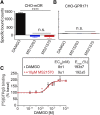Opioid-Induced Signaling and Antinociception Are Modulated by the Recently Deorphanized Receptor, GPR171
- PMID: 31308196
- PMCID: PMC6750184
- DOI: 10.1124/jpet.119.259242
Opioid-Induced Signaling and Antinociception Are Modulated by the Recently Deorphanized Receptor, GPR171
Abstract
ProSAAS is one of the most widely expressed proteins throughout the brain and was recently found to be upregulated in chronic fibromyalgia patients. BigLEN is a neuropeptide that is derived from ProSAAS and was recently discovered to be the endogenous ligand for the orphan G protein-coupled receptor GPR171. Although BigLEN-GPR171 has been found to play a role in feeding and anxiety behaviors, it has not yet been explored in pain and opioid modulation. The purpose of this study was to evaluate this novel neuropeptide-receptor system in opioid-induced antinociception. We found that GPR171 is expressed in GABAergic neurons within the periaqueductal gray, which is a key brain area involved in pain modulation and opioid functions. We also found that, although the GPR171 agonist and antagonist do not have nociceptive effects on their own, they oppositely regulate morphine-induced antinociception with the agonist enhancing and antagonist reducing antinociception. Lastly, we showed that the GPR171 antagonist or receptor knockdown decreases signaling by the mu-opioid receptor, but not the delta-opioid receptor. Taken together, these results suggest that antagonism of the GPR171 receptor reduces mu opioid receptor signaling and morphine-induced antinociception, whereas the GPR171 agonist enhances morphine antinociception, suggesting that GPR171 may be a novel target toward the development of pain therapeutics. SIGNIFICANCE STATEMENT: GPR171 is a recently deorphanized receptor that is expressed within the periaqueductal gray and can regulate mu opioid receptor signaling and antinociception. This research may contribute to the development of new therapeutics to treat pain.
Copyright © 2019 by The American Society for Pharmacology and Experimental Therapeutics.
Figures





Similar articles
-
GPR171 activation regulates morphine tolerance but not withdrawal in a test-dependent manner in mice.Behav Pharmacol. 2022 Oct 1;33(7):442-451. doi: 10.1097/FBP.0000000000000692. Epub 2022 Aug 5. Behav Pharmacol. 2022. PMID: 35942845 Free PMC article.
-
GPR171 is a hypothalamic G protein-coupled receptor for BigLEN, a neuropeptide involved in feeding.Proc Natl Acad Sci U S A. 2013 Oct 1;110(40):16211-6. doi: 10.1073/pnas.1312938110. Epub 2013 Sep 16. Proc Natl Acad Sci U S A. 2013. PMID: 24043826 Free PMC article.
-
The BigLEN-GPR171 Peptide Receptor System Within the Basolateral Amygdala Regulates Anxiety-Like Behavior and Contextual Fear Conditioning.Neuropsychopharmacology. 2017 Dec;42(13):2527-2536. doi: 10.1038/npp.2017.79. Epub 2017 Apr 20. Neuropsychopharmacology. 2017. PMID: 28425495 Free PMC article.
-
The mechanism of μ-opioid receptor (MOR)-TRPV1 crosstalk in TRPV1 activation involves morphine anti-nociception, tolerance and dependence.Channels (Austin). 2015;9(5):235-43. doi: 10.1080/19336950.2015.1069450. Epub 2015 Jul 15. Channels (Austin). 2015. PMID: 26176938 Free PMC article. Review.
-
[Direct involvement of the supraspinal phosphoinositide 3-kinase/phospholipase C gamma 1 pathway in the mu-opioid receptor agonist-induced supraspinal antinociception in the mouse].Nihon Shinkei Seishin Yakurigaku Zasshi. 2003 Jun;23(3):121-8. Nihon Shinkei Seishin Yakurigaku Zasshi. 2003. PMID: 12884752 Review. Japanese.
Cited by
-
A small molecule ligand for the novel pain target, GPR171, produces minimal reward in mice.Pharmacol Biochem Behav. 2023 Mar;224:173543. doi: 10.1016/j.pbb.2023.173543. Epub 2023 Mar 17. Pharmacol Biochem Behav. 2023. PMID: 36933620 Free PMC article.
-
UPLC-MS based integrated plasma proteomic and metabolomic profiling of TSC-RAML and its relationship with everolimus treatment.Front Mol Biosci. 2023 Feb 20;10:1000248. doi: 10.3389/fmolb.2023.1000248. eCollection 2023. Front Mol Biosci. 2023. PMID: 36891236 Free PMC article.
-
The role of orphan G protein-coupled receptors in pain.Heliyon. 2024 Mar 26;10(7):e28818. doi: 10.1016/j.heliyon.2024.e28818. eCollection 2024 Apr 15. Heliyon. 2024. PMID: 38590871 Free PMC article. Review.
-
GPR171 Activation Modulates Nociceptor Functions, Alleviating Pathologic Pain.Biomedicines. 2021 Mar 5;9(3):256. doi: 10.3390/biomedicines9030256. Biomedicines. 2021. PMID: 33807709 Free PMC article.
-
GPR171 Agonist Reduces Chronic Neuropathic and Inflammatory Pain in Male, But Not Female Mice.Front Pain Res (Lausanne). 2021 Sep 10;2:695396. doi: 10.3389/fpain.2021.695396. eCollection 2021. Front Pain Res (Lausanne). 2021. PMID: 35295419 Free PMC article.
References
-
- Azhdari-Zarmehri H, Esmaeili M-H, Sofiabadi M, Haghdoost-Yazdi H. (2013) Orexin receptor type-1 antagonist SB-334867 decreases morphine-induced antinociceptive effect in formalin test. Pharmacol Biochem Behav 112:64–70. - PubMed
Publication types
MeSH terms
Substances
Grants and funding
LinkOut - more resources
Full Text Sources
Molecular Biology Databases
Research Materials

